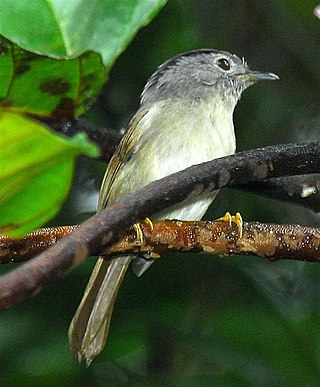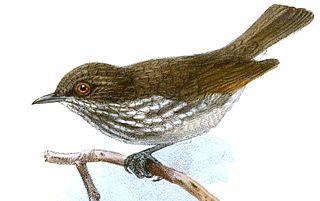
The white-eyes are a family, Zosteropidae, of small passerine birds native to tropical, subtropical and temperate Sub-Saharan Africa, southern and eastern Asia, and Australasia. White-eyes inhabit most tropical islands in the Indian Ocean, the western Pacific Ocean, and the Gulf of Guinea. Discounting some widespread members of the genus Zosterops, most species are endemic to single islands or archipelagos. The silvereye, Zosterops lateralis, naturally colonised New Zealand, where it is known as the "wax-eye" or tauhou ("stranger"), from 1855. The silvereye has also been introduced to the Society Islands in French Polynesia, while the Japanese white-eye has been introduced to Hawaii.

The Taiwan yuhina, also known as Formosan yuhina, is a small songbird endemic to the island of Taiwan.

The flame-templed babbler is a species of bird of the family Zosteropidae, in the genus Dasycrotapha. It is one of the most remarkable and distinctive birds with its complex head markings with orange crown tufts, black ears and yellow beak and face. It is endemic to the Philippines, where it is found on the islands of Panay and Negros. Its natural habitat is tropical moist lowland forest. It is threatened by habitat loss. Along with the Negros striped babbler, it is one of the two babbler species extremely sought after by birdwatchers on Negros.

Pnoepyga is a genus of passerines endemic to southern and southeastern Asia. Its members are known as cupwings or wren-babblers. The genus contains four species. The genus has long been placed in the babbler family Timaliidae. A 2009 study of the DNA of the families Timaliidae and the Old World warblers (Sylviidae) found no support for the placement of the genus in either family, prompting the authors to erect a new monogeneric family, the Pnoepygidae.

Stachyris is a genus of passerine birds in the Old World babbler family, Timaliidae.

The rusty-crowned babbler is a species of bird in the family Zosteropidae. It is native to the southern Philippines on the islands of Mindanao and Dinagat Islands and Basilan. Its natural habitat is tropical moist lowland forest.

The golden-crowned babbler is a species of bird in the family Zosteropidae. It is endemic to the Philippines found only in the moist tropical forest in Northern Luzon. It is threatened by habitat loss.

The Visayan babbler also known as the Visayan Black-crowned Babbler. is a species of bird in the family Zosteropidae. It is endemic to the Philippines. It is found on Samar, Leyte and Bohol. Its natural habitat is tropical moist lowland forest. It was formerly conspecific to the northern population of the Calabarzon black-crowned babbler but has since been split as a species due to differences in its yellowish throat and whiter belly.

The Mindanao pygmy babbler is a bird species endemic to the Philippines. It had been placed in the family Timaliidae, but it is a close relative of the white-eyes, however, and many taxonomists now place it in the family Zosteropidae..

The black-chinned babbler is a babbler species in the family Timaliidae. It occurs in the foothills of the Himalayas from the Murree Hills in Pakistan to eastern Nepal. It inhabits subtropical and temperate forest at 245–2,750 m (804–9,022 ft) altitudes. It is terrestrial. It is listed as Least Concern on the IUCN Red List.

The rufous-capped babbler is a babbler species in the family Timaliidae. It occurs from the Eastern Himalayas to northern Thailand, Laos, eastern China to Vietnam and Taiwan. It inhabits temperate forest with dense bushes or bamboo and is listed as Least Concern on the IUCN Red List.

The rufous-fronted babbler is a babbler species in the Old World babbler family. It occurs from the Eastern Himalayan foothills to Southeast Asia at altitudes of 120–2,100 m (390–6,890 ft).

The white-naped yuhina is a bird species in the white-eye family Zosteropidae.

Yuhina is a genus of birds in the white-eye family Zosteropidae.

The stripe-throated yuhina is a bird species in the white-eye family Zosteropidae.

Alcippe is a genus of passerine birds in the monotypic family Alcippeidae. The genus once included many other fulvettas and was previously placed in families Pellorneidae or Timaliidae.

Zosterornis is a genus of passerine birds in the white-eye family Zosteropidae. The five species in the genus are endemic to the Philippines.

The Visayan pygmy babbler is a bird species endemic to the Philippines on the islands of Leyte and Samar. It was conspecific with the Mindanao pygmy babbler under the common name of "pygmy babbler".Its natural habitats are tropical moist lowland forests and or tropical moist montane forests.

The Calabarzon babbler is a species of bird in the family Zosteropidae. It is endemic to the Philippines found in the island of Luzon. Contrary to its name, it is also found outside the Calabarzon region where it also inhabits Central Luzon, Bicol Peninsula and Catanduanes. Its natural habitat is tropical moist lowland forest. It previously was considered a subspecies of the black-crowned babbler.



















